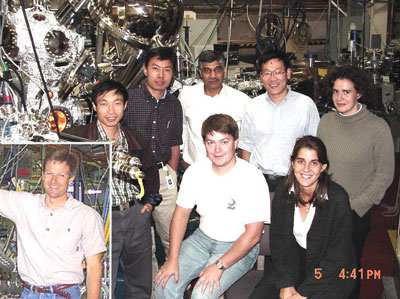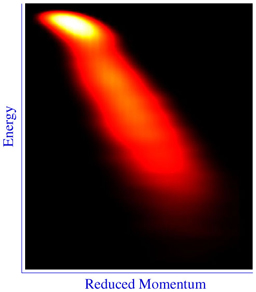|
A study at Berkeley Lab's Advanced Light Source (ALS) has revealed that,
contrary to what many scientists have argued, the physics behind the high-temperature
superconductivity of copper oxides may be every bit as kinky as that behind
their low-temperature metal counterparts.
Working with undulator light from ALS Beamline 10.0, an international
collaboration led by Stanford University physicist Zhi-Xun Shen has identified
a "kink" in the energy spectrum of low-energy electrons in three
different families of copper oxide high-temperature superconductors. This
spectral kink is the signature of an interaction or "coupling"
between an electron and a phonon, a vibration in the ions that form the
lattice of a superconductor's crystal. Electron-phonon coupling is behind
the low-temperature superconductivity of metal alloys.
 |
|
| The team that found the "kink"
in the spectra of high-temperature superconductors included (insert)
Scot Kellar, (seated) Pavel Bogdanov and Alessandra Lanzara, and (back
row from left) Wangli Yang, Xingjiang Zhou, Zahid Husssain, Zhi-Xun
Shen, and Veronique Broet. |
"We see in all of these copper oxide materials an abrupt change
of electron velocity at 50-80 meV" — the kink in the spectrum
— "which we cannot explain by any known process other than the
coupling with phonons," says Shen. "This suggests that electron-phonon
coupling strongly influences the electron dynamics in high-temperature
superconductors and must therefore be included in any microscopic theory
of superconductivity."
Superconductivity is a state in which a material loses all electrical
resistance: once established, an electrical current will flow forever.
Following the discovery in the 1950s of niobium-based metal alloys that
become superconducting at temperatures around 18 degrees Kelvin (18 K),
superconductivity has become a staple of high-tech magnet technology in
scientific research. However, the cost and difficulty of chilling these
metals with liquid helium limit their applications elsewhere.
The discovery in the 1980s of ceramic copper oxides that become superconducting
at temperatures above the 77 K boiling point of liquid nitrogen —
meaning they are much cheaper to chill than metals — brought forth
the tantalizing prospect of room temperature superconductors and their
promise of such prizes as dirt-cheap electrical power and magnetically
levitated high-speed trains. For this promise ever to be realized, however,
scientists need a better understanding of the physics behind the superconductivity
of these materials.
The physics behind low-temperature superconductivity has been successfully
explained by BCS theory, named for its Nobel-prize winning authors, John
Bardeen, Leon Cooper, and Robert Schrieffer. BCS theory says that a superconductor
loses electrical resistance through the formation of electron pairs, in
which any motion on the part of one member of the pair instantly causes
an equal countermotion in the other. This electron pairing cancels out
any disruption in the flow of an electrical current caused by crystal
impurities, a source of electrical resistance.
Electrons that would naturally repel one another because of their mutual
negative charge are able to pair up because of the interaction of one
of them with a phonon, which can be thought of as a sort of atomic sound
wave. The first electron alters the phonon, and the second electron is
affected by this alteration, like passing ships influencing each other's
motion through their effect on the surrounding waves. Scientists believe
electron pairing is also behind the superconductivity of high-temperature
superconductors; however, the prevailing thought has been that this pairing
involves different physics, such as fluctuations of the magnetic spins
of atomic nuclei, rather than electron-phonon coupling.
 |
 |
|
|
 |
Relationships of electron energy and
momentum help scientists better understand the physics behind high-temperature
superconductivity. In this raw ARPES data, photoemission intensity
appears as a function of electron binding energy and electron momentum.
|
|
|
"We would very much like for phonons not to be there. We have a
completely new mechanism for high-temperature superconductivity that has
nothing to do with phonons," Shen says. "However, our data suggest
that the phonon is still a major player in high-temperature superconductivity."
The team led by Shen, which included Berkeley Lab physicist Zahid Hussain
and researchers with Stanford University and the University of Tokyo,
conducted its study of the three families of copper oxide superconductors
at the ALS using a technique called ARPES (angle-resolved photoemission
spectroscopy). With ARPES, light is flashed on a sample, causing electrons
to be emitted through the photoelectric effect. Measuring the kinetic
energy of emitted electrons and the angles at which they are ejected identifies
their velocity and scattering rates. This in turn yields various energy
spectra.
By lighting their samples with the laserlike beams of photons generated
at ALS beamline 10.0.1's undulator magnet, Shen and his colleagues obtained
an angular resolution in their ARPES measurements that was an order of
magnitude better than any previous experiments. The ability to fine-tune
the energy of the undulator's photons made it possible for them to zero
in on the electrons that are directly responsible for superconductivity
and to plot energy spectral curves. The spectral curves revealed a kink
shared by all the samples at an energy matching that of an oxygen phonon.
 |
|
| In these energy spectra, three different
families of high-temperature superconductors all show a common "kink"
(arrow) at the energy that matches an oxygen phonon. |
"Until now there has been little direct evidence for electron-phonon
coupling in high-temperature superconductors," says Shen. "This
was a hard job and we were blessed with both the performance of the ALS
and the amount of beam time made available to us."
While the data gathered by Shen and his team indicate that phonons strongly
influence the motion of electrons in high-temperature superconductors,
it is still not clear to what extent BCS theory can explain the physics
involved. Shen and his colleagues are already planning new experiments
to help answer this question but, in the meantime, they expect their finding
will "stimulate more work" for the theorists.
In addition to Shen and Hussain, other U.S. members of the discovery
team were Stanford University's Alessandra Lanzara, Pavel Bogdanov, Xingjiang
Zhou, Scot Kellar, and Donglai Feng, plus former ALS staffer Erdong Lu.
Additional information:
|

